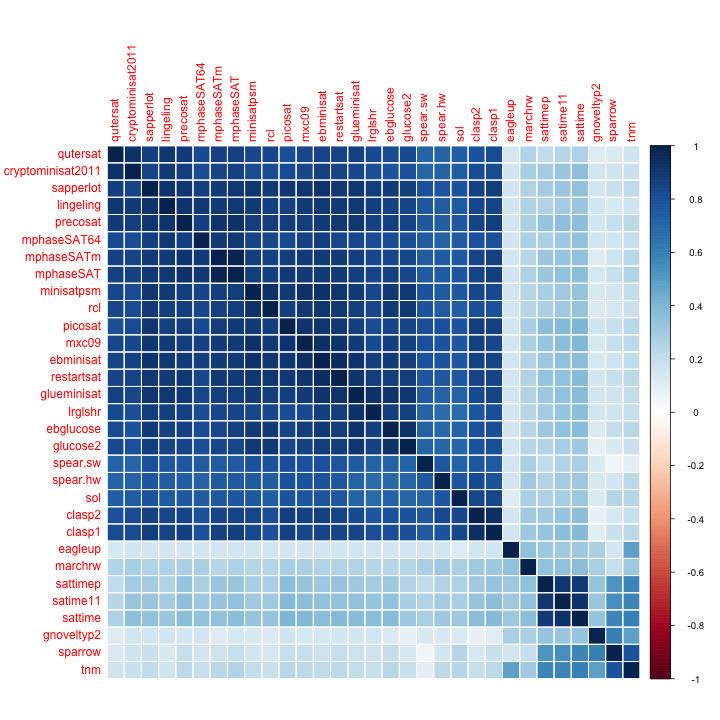 | ||
Algorithm Selection (sometimes also called per-instance algorithm selection or offline algorithm selection) is a meta-algorithmic technique to choose an algorithm from a portfolio on an instance-by-instance basis. It is motivated by the observation that on many practical problems, algorithms have different performances. That is, while one algorithm performs well on some instances, it performs poorly on others and vice versa for another algorithm. If we can identify when to use which algorithm, we can get the best of both worlds and improve overall performance. This is what algorithm selection aims to do. The only prerequisite for applying algorithm selection techniques is that there exists (or that there can be constructed) a set of complementary algorithms.
Contents
- Definition
- Boolean Satisfiability Problem and other Hard Combinatorial Problems
- Machine Learning
- Instance Features
- Static vs Probing Features
- Feature Costs
- Regression Approach
- Clustering Approach
- Pairwise Cost Sensitive Classification Approach
- Requirements
- Application Domains
- Online Selection
- Computation of Schedules
- Selection of Parallel Portfolios
- References
Definition
Given a portfolio
Boolean Satisfiability Problem (and other Hard Combinatorial Problems)
A well-known application of algorithm selection is the Boolean satisfiability problem. Here, the portfolio of algorithms is a set of (complementary) SAT solvers, the instances are Boolean formulas, the cost metric is for example average runtime or number of unsolved instances. So, the goal is to select a well-performing SAT solver for each individual instance. In the same way, algorithm selection can be applied to many other
Machine Learning
In machine learning, algorithm selection is better known as meta-learning. The portfolio of algorithms consists of machine learning algorithms (e.g., Random Forest, SVM, DNN), the instances are data sets and the cost metric is for example the error rate. So, the goal is to predict which machine learning algorithm will have a small error on each data set.
Instance Features
The algorithm selection problem is mainly solved with machine learning techniques. By representing the problem instances by numerical features
Instance features are numerical representations of instances. For example, we can count the number of variables, clauses, average clause length for Boolean formulas, or number of samples, features, class balance for ML data sets to get an impression about their characteristics.
Static vs. Probing Features
We distinguish between two kinds of features:
- Static features are in most cases some counts and statistics (e.g., clauses-to-variables ratio in SAT). These features ranges from very cheap features (e.g. number of variables) to very complex features (e.g., statistics about variable-clause graphs).
- Probing features (sometimes also called landmarking features) are computed by running some analysis of algorithm behavior on an instance (e.g., accuracy of a cheap decision tree algorithm on an ML data set, or running for a short time a stochastic local search solver on a Boolean formula). These feature often cost more than simple static features.
Feature Costs
Depending on the used performance metric
It is important to take the overhead of feature computation into account in practice in such scenarios as otherwise a misleading impression of the performance of the algorithm selection approach is created. For example, if the decision which algorithm to choose can be made with prefect accuracy, but the features are the running time of the portfolio algorithms, there is no benefit to the portfolio approach. This would not be obvious if feature costs were omitted.
Regression Approach
One of the first successful algorithm selection approaches predicted the performance of each algorithm
Clustering Approach
A common assumption is that the given set of instances
A more modern approach is cost-sensitive hierarchical clustering using supervised learning to identify the homogeneous instance subsets.
Pairwise Cost-Sensitive Classification Approach
A common approach for multi-class classification is to learn pairwise models between every pair of classes (here algorithms) and choose the class that was predicted most often by the pairwise models. We can weight the instances of the pairwise prediction problem by the performance difference between the two algorithms. This is motivated by the fact that we care most about getting predictions with large differences correct, but the penalty for an incorrect prediction is small if there is almost no performance difference. Therefore, each instance
Requirements
The algorithm selection problem can be effectively applied under the following assumptions:
Application Domains
Algorithm selection is not limited to single domains but can be applied to any kind of algorithm if the above requirements are satisfied. Application domains include:
For an extensive list of literature about algorithm selection, we refer to a literature overview.
Online Selection
Online algorithm selection in Hyper-heuristic refers to switching between different algorithms during the solving process. In contrast, (offline) algorithm selection is an one-shot game where we select an algorithm for a given instance only once.
Computation of Schedules
An extension of algorithm selection is the per-instance algorithm scheduling problem, in which we do not select only one solver, but we select a time budget for each algorithm on a per-instance base. This approach improves the performance of selection systems in particular if the instance features are not very informative and a wrong selection of a single solver is likely.
Selection of Parallel Portfolios
Given the increasing importance of parallel computation, an extension of algorithm selection for parallel computation is parallel portfolio selection, in which we select a subset of the algorithms to simultaneously run in a parallel portfolio.
